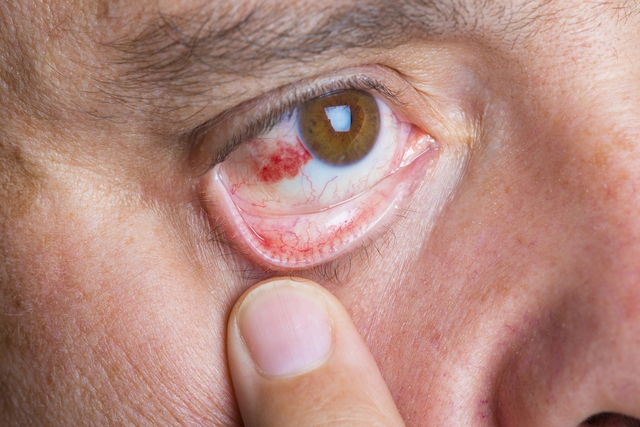A subconjunctival hemorrhage is the rupture of tiny blood vessels located in the conjunctiva, the thin transparent film that covers the white part of the eye. Rupture of these vessels lead to a red patch of blood in the eye.
A subconjunctival hemorrhage, also called hyposphagma, is a fairly common condition that does not affect the inside of the eye and does not affect vision. Hyposphagma can be caused by increased blood pressure, the use of blood clotting medication and blows to the eye, for example.
In most cases, the bleed in the eye heals itself, and disappears after about 10 to 14 days without any treatment. However, if symptoms persist, you are advised to consult an ophthalmologist.

Common symptoms
The main symptom of a subconjunctival hemorrhage is redness in the eye. This bleed does not cause any changes to vision, as the bleeding only affects the outermost part of the eye. However, in some cases, you may have the feeling that something is in your eye.
Broken blood vessels in babies
Noting a broken blood vessel in a baby's eye is common and deemed an uncomplicated condition. It is often caused by the baby scratching his or her eye or by specific moments of exertion, such as sneezing or coughing. Normally, the blood in the eye disappears within 2 or 3 weeks.
In cases where the blood patch in the eye persists and the baby also presents with a fever, a pediatrician should be consulted, as this could be a sign of an eye infection such as pink eye. Learn more about pink eye in babies and how it presents.
Main causes
The main causes of subconjunctival hemorrhage:
- Allergies
- Direct trauma, such as scratching or rubbing the eye
- Physical exertion such as heavy lifting or intense physical activity
- Prolonged coughing
- Repeated sneezing
- Straining with bowel movements
- Episodes of intense vomiting
- Serious eye infections
- Eye or eyelid surgery
- Use of medication that interferes with blood clotting
In addition, although infrequent, a subconjunctival hemorrhage can also occur due to spikes in blood pressure and changes in blood clotting.
Treatment options
In most cases, a subconjunctival hemorrhage does not require treatment, as the blood is reabsorbed after a few days. However, in some cases, the ophthalmologist may recommend applying a cold water compress to the eye twice a day.
If the subconjunctival hemorrhage doesn't improve after a few days, it's important to see your doctor for further assessment. He or she may conduct eye pressure and blood pressure checks.
